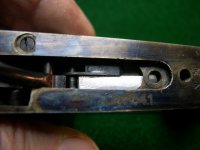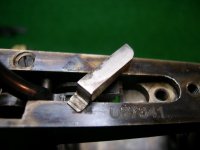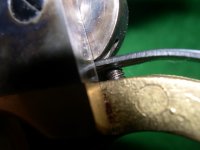Head Tomcat
New member
Guys,
Now that the Kirst gated conversion is properly installed on my Uberti 1851 Navy London pistol and the arbor is the correct length (again, thanks 45 Dragoon…you were correct!!!), it is coming up to tune the action for correct timing.
Right now I have deburred all necessary areas of the pistol and installed Lee gunslinger springs for the bolt and hammer. The action feels very smooth and easy to handle. The question I have is with regard to the timing of the “clicks” so I get this:
• Click 1 – Safety notch
• Click 2 – Bolt dropping onto the cylinder the wide of one notch away
• Clicks 3 and 4 (simultaneously, or darn close) – trigger into its notch and bolt into its cylinder slot…also, hammer hits hard stop just as it as the two simultaneous clicks occur
Right now the Uberti is doing this:
• Click 1 – Safety notch
• Click 2 – Bolt dropping on the cylinder (right now it is dropping 1 ½ notch-widths away from its proper slot)
• Click 3 – Trigger drops into is notch
• Click 4 – Bolt drops into its cylinder slot
Clicks 3 and 4 are close together but you can hear the trigger dropping into its notch while the bolt is still about half of a notch-width away from dropping. Close, but not close enough.
Also, the hammer goes another ¼ inch past Click 4 before it comes to a hard stop.
What is recommended to get Clicks 3 and 4 to be simultaneous (or darn close) and also the hammer to hit a hard stop just as these final two clicks take place?
Whew…and thanks!
Head Tomcat
Now that the Kirst gated conversion is properly installed on my Uberti 1851 Navy London pistol and the arbor is the correct length (again, thanks 45 Dragoon…you were correct!!!), it is coming up to tune the action for correct timing.
Right now I have deburred all necessary areas of the pistol and installed Lee gunslinger springs for the bolt and hammer. The action feels very smooth and easy to handle. The question I have is with regard to the timing of the “clicks” so I get this:
• Click 1 – Safety notch
• Click 2 – Bolt dropping onto the cylinder the wide of one notch away
• Clicks 3 and 4 (simultaneously, or darn close) – trigger into its notch and bolt into its cylinder slot…also, hammer hits hard stop just as it as the two simultaneous clicks occur
Right now the Uberti is doing this:
• Click 1 – Safety notch
• Click 2 – Bolt dropping on the cylinder (right now it is dropping 1 ½ notch-widths away from its proper slot)
• Click 3 – Trigger drops into is notch
• Click 4 – Bolt drops into its cylinder slot
Clicks 3 and 4 are close together but you can hear the trigger dropping into its notch while the bolt is still about half of a notch-width away from dropping. Close, but not close enough.
Also, the hammer goes another ¼ inch past Click 4 before it comes to a hard stop.
What is recommended to get Clicks 3 and 4 to be simultaneous (or darn close) and also the hammer to hit a hard stop just as these final two clicks take place?
Whew…and thanks!
Head Tomcat



